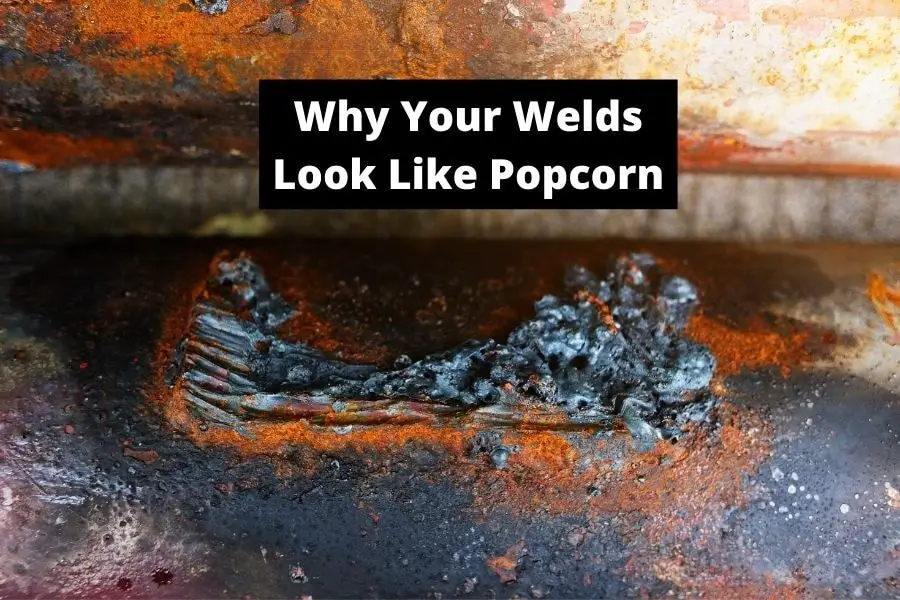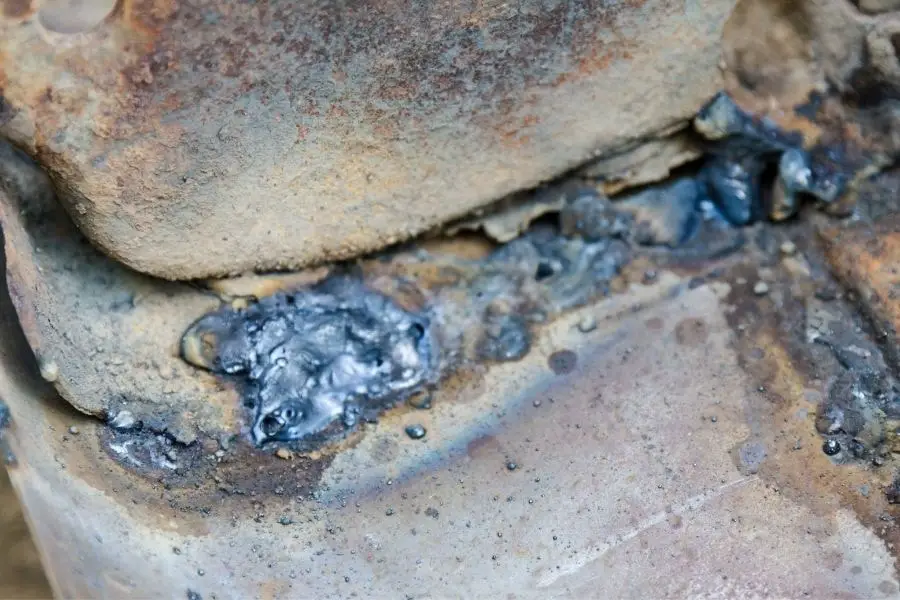Welding is a sensitive sort of work. Even the slightest of mistakes or miscalculations can cause your weld to fail. A problem many new to welding faces is their welds looking like popcorn. It definitely shouldn’t look like that. So, what’s the deal? – you might be wondering. Well, these might be the reasons why your welds look like popcorn.
A weld may look like popcorn when the wire is speeding too fast or slow or when the fire feeding happens before the melting. If you use solid wire without shielding gas, you might also hear popping sounds. Other reasons may include the wire’s incorrect size, amperage adjustments and voltage.

In this article, I will be talking about why your welds look like popcorn in detail and how to fix them as there might be multiple issues causing you this problem. You’ll have to take a few approaches to fix this issue and make sure it doesn’t happen again. So, read till the end for a detailed understanding on the problem.
Reasons Your Welds Are Popping
The prime reason that might make your welds pop is the incorrect speed of the wires. To test the speed, you’ll want to hold up your welder on the material you wish to weld. If the weld’s trigger makes a loud pop and attempts to push back the gun, you can assume that the speed is not right and adjust it.
Besides the speed, other aspects like the wire’s size and type may also make your welds pop. Multiple reasons make your welds look like popcorn, but let’s get into three of the most common ones.
- The Wire’s Diameter and Type
You’ll have to work with either flux core wires or solid wires with welding, but the speed may not be the same according to the kind of material on which you’re using the weld. In both cases of wires, there is a separate set of recommendations from experts about the diameter of the wire, amperage, and speed for specific material thicknesses.
Flux wires are the best option if you want large diameters and more amperage because solid wires may not be as powerful as flux. Besides, you’ll also need to know which speed works the best for the type of wire you’re using.
Incorrect wire type and speed will make your welds pop for sure. For example, a wire having a diameter of 0.35 will work best with 50-180 amperage at 80-380 inches per minute speed. Make sure you’re checking the manual for the ideal settings before you start welding.
- The Material’s Thickness
If your material is thin, you’ll need more inches per minute (IPM). The faster the speed, the better and more quickly the weld will penetrate through the material. The IPM is not the same for thick and thin surfaces, so you’ll need to know which speed is preferable for what material.
The amperage depends on the material’s thickness, which goes in hand with the wire’s speed, which is the main reason for the popcorn effect. Some welders run theirs too slow without taking the surface thickness into account, while others may go too fast. When that happens, your weld will undoubtedly pop.
You’ll need to remember that for thicker materials, you’ll need a slower IPM, whereas if you’re using a thin surface, you’ll need a faster IPM. The standard rule has an output of one amp for ¼ inch thick metal, which is the best setting unless a seasoned welder recommends you otherwise for your material.
- Amperage and Voltage
As I’ve already mentioned, the amperage is the most crucial factor after speed that makes your welds pop. If you don’t have the right amperage settings, you won’t have an efficient welding speed, making your welds look like popcorn.
The amperage may make your wire melt faster and burn hotter or colder than necessary. With the ampere, you also have to adjust the voltage if you want your desired effects. You’ll want to follow the standard rule I’ve mentioned previously, for your amperage as well.
As setting the amperage may be a bit tricky, you can partner with an expert and experiment with the right voltage and amperage levels if you’re a beginner. Keep making notes till you get the general idea of how things work, and you should be okay.

How Do You Fix Your Weld’s Popping?
Now that you know why your welds look like popcorn, you try a few things to stop this problem, so here are three possible fixes to your popping weld problem.
- Adjusting Your Wire Speed and Your Welding Gun’s Tip
The main reason that makes your weld pop is the speed itself, so undoubtedly, you’ll need to check the speed first. It’s a common misconception that more speed equals more work done, making the welder look better.
To correct the speed, you’ll need to adjust the speed up and down till you hear a constant buzz as you work your weld. If there’s a buzzing sound, your weld shouldn’t pop anymore, and you’ve successfully fixed the issue.
Besides the speed, you should also check the tip of your welding gun. Frequently, splatters or dirt may plug the tip of the gun. Other times, the tip can also have dirt burned within it, making the wire stick. If that happens, you should not use the old tip and replace it with a new one.
- Rusty and Incorrect Wire Size
If your wire continues to sit inside a garage or open workstation, it may become rusty, especially if it has access to moisture. Rusty wires can also make your wires stick when passing through the welding gun. It will make the gun jerk, giving it the popcorn effect. You can replace the old wire with new ones if it rusts cover it entirely.
Besides, you could try putting a shop rag on it and put a clothespin on it to eliminate the rust and dirt when you use your welds. Once you are done, it’s best to cover the wire with a blanket to prevent dust and rust collection on the cables. Additionally, make sure you’ve got the correct size in your welder.
- Checking the Liners
The last tip I have for you is to maintain and check the liner that leads your welder. The lead cable is the one coming from your welder and going to welding the gun. Inside the gun, you’ll find a liner that gives the wire protection when it goes through the rollers, the lead, and the gun.
You have to check from time to time whether the liner is clogged with dirt, which might make your wires stick and make your welds pop. Welding shops are not the cleanest working places and are also home to dust and debris.
If the liner is filled with dirt, the welder will pop. So, replace the liners with new ones, and you might solve your popping issue.
Besides the three tips I’ve mentioned, you should also adjust the voltage and the amperage. With the correct setting of amperage, voltage, and speed according to the material type, you can stop your welds from looking like popcorn.
Conclusion
Although it may seem a bit harsh, most beginners do not pick the right settings successfully for wire speed and amperage when welding. But you now know a bit more about why your welds look like popcorn. So, hopefully, you can fix popping issues with your welds in the future. Just follow my advice and you will be a pro-welder in no time.
Thanks for reading and until next time, farewell.
